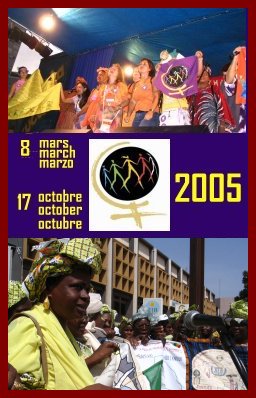2005 Actions Report

By Brigitte Verdière
the Women's Global Charter for
Humanity
CONTENTS
The Relay of the Charter and the Quilt, March 8 2005 – October 17, 2005
- In the Americas
- In Europe
- In Asia and Oceania
- In the Middle East and Arab World
- In Africa
Struggles highlighted during the Relay
- Against neoliberalism, capitalism, patriarchy
- Against violence against women and sexual trafficking
- Against State inaction to put an end to gender discrimination
- For peace and demilitarisation
- For land access and food sovereignty
- For equal employment rights
Using the Charter day to day
Actions across borders
The Charter translated in many languages
The Media and the Relay of the Charter
October
17, 24 hours of solidarity - a real success
|
PAGES OF OUR HISTORY Once upon a time, 6000 women’s groups hailing from 164 countries and territories came together in solidarity to fight for the eradication of poverty and violence against women. Gathered together in the World March of Women, these groups have been acting since 1998 to promote 17 demands they share. In late 2004, they adopted the Women's Global Charter for Humanity, an instrument written collectively and endorsed by consensus within the World March. On December 10, 2004, in Kigali, Rwanda, the delegates at the 5th International Meeting of the World March of Women adopted the Charter, which presents, in 31 affirmations, the world that women want to build. In such a world, exploitation, oppression, intolerance and exclusion no longer exist, and integrity, diversity, and the rights and freedoms of all women and men are respected. It is a world based on equality, freedom, solidarity, justice and peace. After the Charter was launched on March 8, 2005, the women of the World March organized a relay to take it around the world. The relay wended its way through some 60 countries and territories, ending on October 17, 2005, International Day for the Eradication of Poverty. During the relay, the women of the March staged actions to raise awareness and inform people about the Charter’s contents, calling on their representatives and public opinion. They also reflected the Charter’s contents on squares of a patchwork quilt that were sewn together as the relay proceeded. The relay was no mean feat. On two occasions, the suitcase containing the cloth copy of the Charter and the quilt squares was lost. After many phone calls and other steps taken, the suitcase was found, but some national coordinating bodies had to start over and make a new square. The final patchwork quilt consists of 64 squares. Approximately 40 countries took part in actions to mark the end of the relay, on October 17, and to show their support for the values espoused in the Charter. It is difficult to estimate the total number of women who participated in the actions: 12,000 here, 300 there, 15 somewhere else, but we do know that our ideas are making headway and that the Charter will be a reference that women and men will turn to more and more. Here we tell you, in pictures, the story of this
history full of struggles, imagination, creativity and solidarity. |
Read the entire report by downloading our document . pdf



